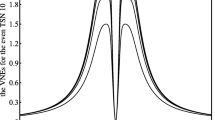Abstract
Joint density of states (JDoS), which depends both on energy and another variable like order parameter provides more information than the conventional density of states (DoS) which depend only on energy. Calculation of JDoS requires huge computational time. In this paper we employ two level method to calculate JDoS which requires relatively much less computational time. We demonstrate this method on a two dimensional Ising spin system, lattice spin model of double strand DNA (dsDNA) and Heisenberg ferromagnet.













Similar content being viewed by others
References
Wang, F., Landau, D.P.: Efficient, multiple-range random walk algorithm to calculate the density of states. Phys. Rev. Lett. 86, 2050 (2001)
Rathore, N., de Pablo, J.J.: Monte Carlo simulation of proteins through a random walk in energy space. J. Chem. Phys. 116, 7225–7230 (2002)
Suman Kalyan, M., Murthy, K.P.N.: Monte Carlo study of force induced melting of DNA hairpin. Physica A 428, 38–45 (2015)
Yamaguchi, C., Okabe, Y.: Three-dimensional antiferromagnetic q-state Potts models: application of the Wang-Landau algorithm. J. Phys. A: Math. Gen. 34, 8781 (2001)
Zhou, C., Schulthess, T.C., Torbrugge, S., Landau, D.P.: Wang-Landau algorithm for continuous models and joint density of states. Phys. Rev. Lett. 96, 120201 (2006)
Okabe, Y., Tomita, Y., Yamaguchi, C.: Application of new Monte Carlo algorithms to random spin systems. Comput. Phys. Commun. 146, 63–68 (2002)
Jayasri, D., Sastry, V.S.S., Murthy, K.P.N.: Wang-Landau Monte Carlo simulation of isotropic-nematic transition in liquid crystals. Phys. Rev. E 72, 036702 (2005)
Mukhopadhyay, K., Ghoshal, N., Roy, S.K.: Monte Carlo simulation of joint density of states in one-dimensional Lebwohl–Lasher model using Wang–Landau algorithm. Phys. Lett. A 372, 3369–3374 (2008)
Tolédano, J.C., Tolédano, P.: The Landau Theory of Phase Transitions. World Scientific publishing Co. Pte. Ltd., Singapore (1987)
Landau, D.P., Tsai, S-H., Exler, M.: A new approach to Monte Carlo simulations in statistical physics: Wang-Landau sampling. Am. J. Phys. 72, 1294–1302 (2004)
Gervais, C., Wüst, T., Landau, D.P., Xu, Y.: Application of the Wang–Landau algorithm to the dimerization of glycophorin. J. Chem. Phys. 130, 215106 (2009)
Kumar, Santosh: Random matrix ensembles: Wang-Landau algorithm for spectral densities. EPL 101, 20002 (2013)
Maerzke, K.A., Gai, L., Cummings, P.T., McCabe, C.: Simulating phase equilibria using Wang-Landau-transition matrix Monte Carlo. J. Phys. 487, 012002 (2014)
Brush, Stephen G.: History of the Lenz-Ising model. Rev. Mod. Phys. 39, 883 (1967)
Li, M.S., Cieplak, M.: Folding in two-dimensional off-lattice models of proteins. Phys. Rev. E. 59, 970 (1999)
Go, N., Abe, H.: Noninteracting local-structure model of folding and unfolding transition in globular proteins. I. Formulation. Biopolymers 20, 991–1011 (1981)
Carmesin, I., Kremer, K.: The bond fluctuation method: a new effective algorithm for the dynamics of polymers in all spatial dimensions. Macromolecules 21, 2819–2823 (1988)
Mishra, G., Giri, D., Li, M.S., Kumar, S.: Role of loop entropy in the force induced melting of DNA hairpin. J. Chem. Phys. 135, 035102 (2011)
Acknowledgments
Computations were carried out i) in SHAKTI cluster at Manipal Centre for Natural Sciences, Manipal University ii) at Centre for Modelling, Simulation and Design (CMSD), University of Hyderabad.
Author information
Authors and Affiliations
Corresponding author
Rights and permissions
About this article
Cite this article
Kalyan, M.S., Bharath, R., Sastry, V.S.S. et al. Joint Density of States Calculation Employing Wang–Landau Algorithm. J Stat Phys 163, 197–209 (2016). https://doi.org/10.1007/s10955-016-1472-5
Received:
Accepted:
Published:
Issue Date:
DOI: https://doi.org/10.1007/s10955-016-1472-5




